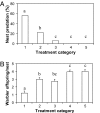Retaliatory mafia behavior by a parasitic cowbird favors host acceptance of parasitic eggs
- PMID: 17360549
- PMCID: PMC1838626
- DOI: 10.1073/pnas.0609710104
Retaliatory mafia behavior by a parasitic cowbird favors host acceptance of parasitic eggs
Abstract
Why do many hosts accept costly avian brood parasitism even when parasitic eggs and nestlings differ dramatically in appearance from their own? Scientists argue that evolutionary lag or equilibrium can explain this evolutionary enigma. Few, however, consider the potential of parasitic birds to enforce acceptance by destroying eggs or nestlings of hosts that eject parasitic eggs and thereby reject parasitism. This retaliatory "mafia" behavior has been reported in one species of parasitic cuckoo but never in parasitic cowbirds. Here we present experimental evidence of mafia behavior in the brown-headed cowbird (Molothrus ater), a widely distributed North American brood parasite. We manipulated ejection of cowbird eggs and cowbird access to predator-proof nests in a common host to test experimentally for mafia behavior. When cowbird access was allowed, 56% of "ejector" nests were depredated compared with only 6% of "accepter" nests. No nests were destroyed when cowbird access was always denied or when access was denied after we removed cowbird eggs, indicating that cowbirds were responsible. Nonparasitized nests were depredated at an intermediate rate (20%) when cowbirds were allowed access, suggesting that cowbirds may occasionally "farm" hosts to create additional opportunities for parasitism. Cowbirds parasitized most (85%) renests of the hosts whose nests were depredated. Ejector nests produced 60% fewer host offspring than accepter nests because of the predatory behavior attributed to cowbirds. Widespread predatory behaviors in cowbirds could slow the evolution of rejection behaviors and further threaten populations of some of the >100 species of regular cowbird hosts.
Conflict of interest statement
The authors declare no conflict of interest.
Figures

Similar articles
-
Rates of parasitism, but not allocation of egg resources, vary among and within hosts of a generalist avian brood parasite.Oecologia. 2017 Jun;184(2):399-410. doi: 10.1007/s00442-017-3870-z. Epub 2017 Apr 20. Oecologia. 2017. PMID: 28429139
-
Brood parasite eggs enhance egg survivorship in a multiply parasitized host.Proc Biol Sci. 2012 May 7;279(1734):1831-9. doi: 10.1098/rspb.2011.2047. Epub 2011 Dec 7. Proc Biol Sci. 2012. PMID: 22158956 Free PMC article.
-
Increased egg-nest visual contrast does not induce egg ejection in the eastern phoebe (Sayornis phoebe), an accepter host of the brood parasitic brown-headed cowbird (Molothrus ater).J Comp Psychol. 2019 Feb;133(1):46-55. doi: 10.1037/com0000130. Epub 2018 Jul 26. J Comp Psychol. 2019. PMID: 30047742
-
Cognition and the brain of brood parasitic cowbirds.Integr Zool. 2019 Mar;14(2):145-157. doi: 10.1111/1749-4877.12312. Integr Zool. 2019. PMID: 29436765 Review.
-
The neuroethology of avian brood parasitism.J Exp Biol. 2021 Sep 1;224(17):jeb222307. doi: 10.1242/jeb.222307. Epub 2021 Sep 6. J Exp Biol. 2021. PMID: 34486660 Review.
Cited by
-
The modelling of avian visual perception predicts behavioural rejection responses to foreign egg colours.Biol Lett. 2008 Oct 23;4(5):515-7. doi: 10.1098/rsbl.2008.0279. Biol Lett. 2008. PMID: 18593669 Free PMC article.
-
Decision-making at the time of parasitism: cowbirds prefer to peck eggs with weaker shells.Anim Cogn. 2022 Apr;25(2):275-285. doi: 10.1007/s10071-021-01549-6. Epub 2021 Aug 17. Anim Cogn. 2022. PMID: 34405287
-
Sheep in wolf's clothing: host nestling vocalizations resemble their cowbird competitor's.Proc Biol Sci. 2008 May 7;275(1638):1061-5. doi: 10.1098/rspb.2007.1706. Proc Biol Sci. 2008. PMID: 18252675 Free PMC article.
-
Reed warbler hosts fine-tune their defenses to track three decades of cuckoo decline.Evolution. 2013 Dec;67(12):3545-55. doi: 10.1111/evo.12213. Epub 2013 Aug 8. Evolution. 2013. PMID: 24299407 Free PMC article.
-
Signal detection and optimal acceptance thresholds in avian brood parasite-host systems: implications for egg rejection.Philos Trans R Soc Lond B Biol Sci. 2020 Jul 6;375(1802):20190477. doi: 10.1098/rstb.2019.0477. Epub 2020 May 18. Philos Trans R Soc Lond B Biol Sci. 2020. PMID: 32420851 Free PMC article. Review.
References
-
- Payne RB. Annu Rev Ecol Syst. 1977;8:1–28.
-
- Rothstein SI, Robinson SK, editors. Parasitic Birds and Their Hosts: Studies in Coevolution. New York: Oxford Univ Press; 1988.
-
- Hoover JP. Anim Behav. 2003;65:923–934.
-
- Brooke MdeL, Davies NB. Nature. 1988;335:630–632.
-
- Lotem A, Rothstein SI. Trends Ecol Evol. 1995;10:436–437. - PubMed
Publication types
MeSH terms
LinkOut - more resources
Full Text Sources
Other Literature Sources
Miscellaneous

